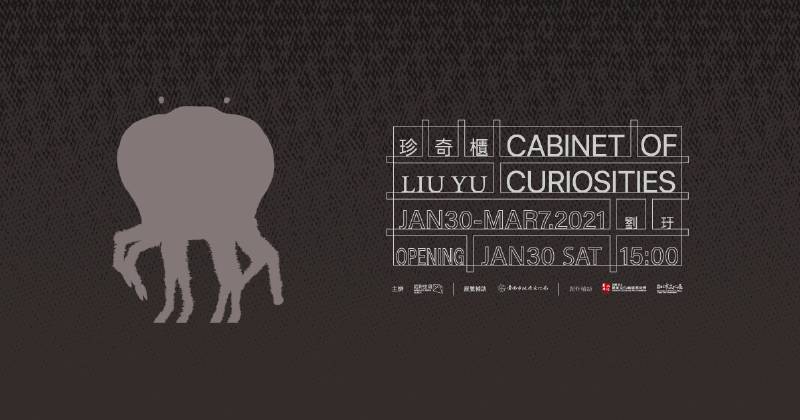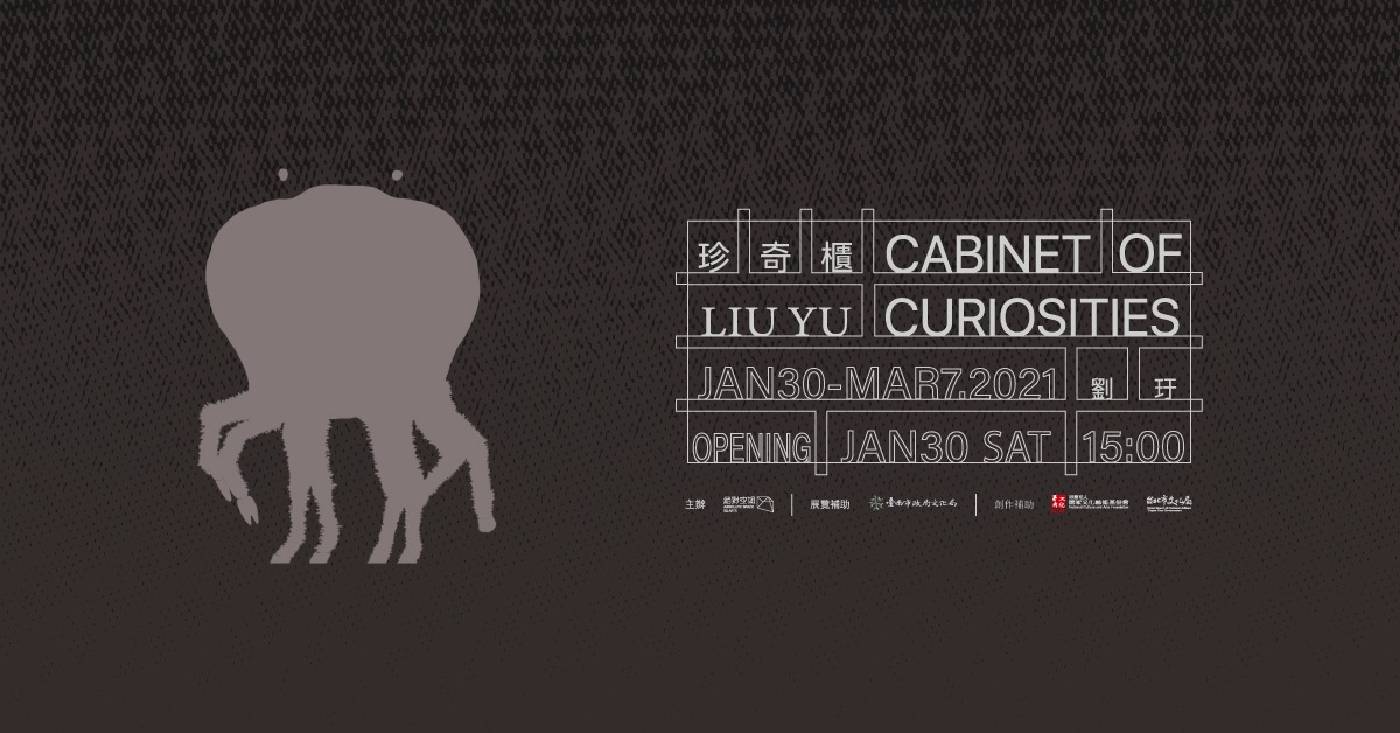絕對空間
【珍奇櫃—劉玗個展】

-
展期
日期:2021-01-30 ~ 2021-03-07
-
地點
台南市中西區民生路一段205巷11號
-
參展藝術家
劉玗
-
Georgo Eberhard Rumphius(1627-1702)是一位十七世紀受僱於荷屬東印度公司的生物學家,一六五四年跟隨船隊抵達印尼安汶島(Ambon),從此長住此地四十八年以至離世。Rumphius尤其狂熱於植物與貝類研究,其重要著作《安汶植物標本誌》裡發表的植物高達一千兩百個物種,包含明確命名九百三十種,奠定了印尼馬魯古群島地區的生物基礎。Rumphius留下的大量研究資料也間接促成了卡爾.林奈(Carl von Linné)在一七五三年建置的「二名法」,甚至有支持者認為是林奈竊取了Rumphius的研究成果。這個大命名的時代成了物種資料化的開端,也演變成現在我們認識動植物的科學基礎。
相較於其他生物學家的不同之處,Rumphius在一六七〇年因青光眼而導致完全失明,卻能持續進行物種研究工作,若我們翻閱Rumphius在研究筆記中描寫植物的資料,會發現其使用了大量的比喻法來描述物種,包含嗅覺與觸覺的,甚至是用人類的性格來描述一株植物。以一種個人式的感性詮釋來記憶、圖索與建檔,使得這些生物在他腦海中建立了另一種抽象型態的資料庫。
本次展覽「珍奇櫃(Cabinet of curiosities)」的內容是劉玗自二〇一八年至今對Rumphius的研究與延伸詮釋,包含Rumphius的相關文件資料、數十張繪製練習與兩部分紀錄片。其中「繪製練習」的文本出自於Rumphius在《安汶珍奇櫃》(The Ambonese Curiosity Cabinet)一書,物種的形體在書中被轉換成抽象的文字描述,而劉玗則試圖將Rumphius的形容詞再圖像化。兩部分別於印尼與荷蘭拍攝的紀錄片《失明的造物主》,搜集了不同領域學者採訪、實地拍攝與資料採集,從兩個不同文化與地緣的脈絡回朔Rumphius過去與現在的輪廓。
劉玗追溯Rumphius的研究並不落腳於自然史的脈絡重整,而是欲捕捉某種人類詮釋世界的方法。相較於科學時代之後我們所認知的世界與原始文化體系的世界,兩者對於萬物的詮釋方式是否仍然牽連著某種感性的交織?不管是在哪一種文化體系之下,在「認知世界」的過程中同時需要另一種反向的生產力活動:想像力的迸發,而這也是某種藝術生產的原始狀態。不管是透過「比喻」、「擬人」、「借代」等各種修辭方法來描繪更多的自然萬物,但始終無法描述的,是人類為何狂熱?
【Statement】
Georgo Eberhard Rumphius (1627-1702) was a biologist employed by the Dutch East India Company in the 17th century. He arrived in Ambon, Indonesia, with a fleet of ships in 1654 and had since lived there for 48 years until his death. Rumphius was particularly enthusiastic about researching plants and shellfish. His important work Herbarium Amboinense covers up to 1,200 botanical species, 930 with definite species names, laying the biological groundwork of Maluku, Indonesia. The extensive research data left by Rumphius also indirectly led to the formalization of Carl von Linné’s binomial nomenclature. Some supporters even believe that Linné had stolen Rumphius' research. This era of big nomenclature became the beginning of species documentation and has evolved into the scientific basis of our current understanding of plants and animals.
In contrast with other biologists, Rumphius became completely blind due to glaucoma in 1670, but was able to continue his research work on species. If we look at Rumphius' descriptions of plants in his notes, we would realize that he used a large number of comparisons to describe species, including olfactory and tactile ones, and he even described plants with human personalities. By using a personal and perceptual interpretation to remember, map and document these creatures, he had created another kind of abstract database in his mind.
The exhibition Cabinet of Curiosities is a collection of Liu Yu’s research and extended interpretations of Rumphius from 2018 to the present, including documents on Rumphius, dozens of drawing exercises, and two documentaries. The text of the drawing exercises is from Rumphius' book The Ambonese Curiosity Cabinet, in which the forms of the species are transformed into abstract textual descriptions. Liu Yu attempted to retransform Rumphius' adjectives into images. The two documentaries Caecus creaturae, respectively shot in Indonesia and the Netherlands, include interviews from scholars of different fields, on-site filming and data collection, retracing the contours of Rumphius' past and present from two different cultural and geographical contexts.
Liu's study of Rumphius does not focus on the reorganization of natural history, but on capturing a certain way of interpreting the world by human beings. Comparing the world we know after the scientific era and the world of primitive cultures, is there still some kind of sensibility interwoven in the way people interpret everything? In either cultural system, the process of "knowing the world" requires another kind of reverse productive activity: the explosion of imagination, which is also some kind of original state when art is created. No matter how hard we try to depict more things in this world, whether through "comparisons," "personification," or "metonymy," we still fail to describe what makes humans frenzy.
---
【關於藝術家劉玗】
出生於一九八五年,目前居住及創作於臺北。作品形式涵蓋錄像、裝置、文字等多種形式,逐漸發展出一系列紀錄式田野的工作模式。從人類的視點、空間屬性的變化與物在體系中流動的身份,作為勾勒人類演進的過程。從隱匿在社會結構下的族群作為研究主題發展了一系列的作品,這些族群的存在總是可以對照出當下社會或歷史結構中的時間切面,將我們日常熟悉嚴謹的體制、科學方法做一種模糊分界的重組工作。
作品中參考了多種影像語彙的原形,從文字出版、紀實影像仿電影形式、類紀錄片的形式,由於大量現地的田調與文獻資料的搜集,也促使我重新編排了這些語言的可能,從空間、歷史、影像、敘事各種零碎的片段,做一相互緊密連結、補敘的整合工程。
Born in 1985. Lives and works in Taipei. Employing a variety of mediums such as video, installation, and texts, Yu Liu’s gradually develop a series of field studies of documentary nature as a kind of working methodology in relation to her artistic practice. How human visions the world, how attributes of spaces change, and how things are constantly being defined in a system — these all contribute to giving an account on the progression of humanity. A series of works are later created with a research focus on less visible communities marginalized by structural societal factors. The existence of these communities often reflects the intricacies of its contemporary society, and, furthermore, offers a sample of a specific historical moment with regard to a grander context—a boundary-breaking reexamination that helps disrupt strictly defined scientific methodologies and the science institution with which we are all too familiar.
